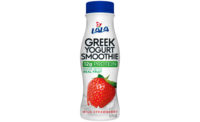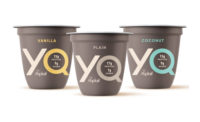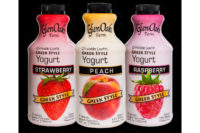Formulating high-protein drinkable yogurts
Follow a few tips and pay attention to the protein chemistry.

One of the ways to add differentiation and consumer appeal to a fermented dairy drink is to increase the protein content. But adding protein to any cultured product typically results in an increase in viscosity.
Drinkable products are typically lower in total solids than spoonable products, which also helps make them more fluid. Many high-protein spoonable yogurts contain 9-10% protein (i.e., 15-17 grams protein/5.3 ounces), and whether they are made through straining or fortification, they have a very thick texture. So how do you make a high-protein yogurt drinkable?
A comparison
If we look at two drinkable yogurt products on the market that contain 25 grams protein in a 10-ounce serving (~8.4% protein), we will find differences in the formulations and big differences in the texture. One product uses cultured Grade A nonfat milk and whey protein concentrate (WPC) as the protein sources, while the other uses only cultured low-fat milk.
The product that uses WPC (likely a WPC80) is very fluid, smooth and drinkable. The product that uses only cultured low-fat milk (likely a high-protein strained yogurt) would not even pour out of the bottle when it was tipped upside down (based on testing two flavors). It had to be squeezed out of the bottle into a glass and consumed with a spoon. Why the big differences in texture with the same amount of protein?
The explanation requires a quick review of the differences in functionality between caseins and whey proteins. One of the characteristics of casein is its ability to form acid gels. When yogurt is made, the gel is formed through the addition of lactic-acid-producing bacteria. Typically, the more casein in the formula, the stronger the gel.
Milk contains both casein (~80% of the protein) and whey protein (~20% of the protein). In yogurt manufacture, milk is typically pasteurized at high temperatures (195 degrees Fahrenheit for 5-10 minutes), which creates some denaturation of the whey protein and formation of disulfide bonds with casein. This reaction further strengthens the gel and provides better water-holding capacity to help prevent syneresis during the yogurt’s shelf life.
Whey proteins do not have the ability to form acid gels; rather, they remain soluble in acid conditions if in an undenatured form. Fortifying with whey protein is a great option to maintain a fluid consistency, but it is very heat-sensitive. So to avoid graininess when increasing the whey protein content, due to denaturation and loss of solubility, you must decrease the pasteurization temperature to about 170 degrees Fahrenheit for less time. You could also try a heat-stable whey protein ingredient.
Adding whey protein is not the only way to increase protein in a drinkable product. But following these tips and paying attention to the protein chemistry can help you avoid having to squeeze your high-protein “drinkable” yogurt out of the bottle.
Looking for a reprint of this article?
From high-res PDFs to custom plaques, order your copy today!






